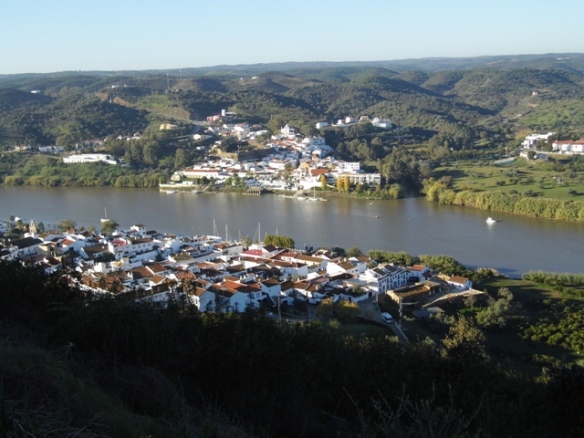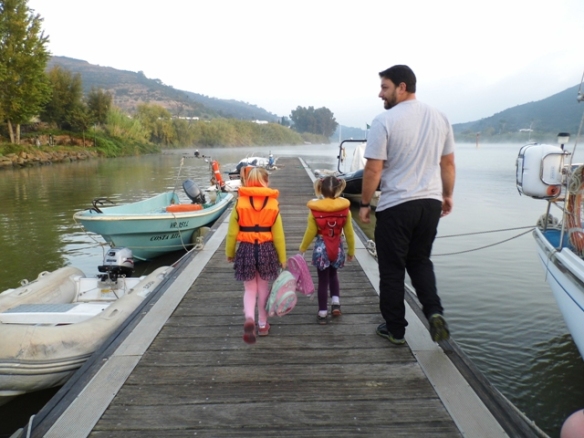Next week marks a year since we sailed Carina into the Río Guadiana. I wasn’t sure what to expect as we turned north from the Atlantic coast of southern Spain and into the river, but it wasn’t this. Live aboards we met on Ilha da Culatra in the autumn of 2014 sang the praises of the river and told us we had to check it out. We sailed past on our way into the Mediterranean, but sailing west back out of the Med seven months later, we thought we’d better go see what all the fuss was about.
I had heard of the strong floods that visit the river from time to time, and I knew there were two marinas not far from the river mouth – Ayamonte in Spain and Vila Real de Santo Antonio in Portugal. And I knew the river was navigable some way up. Beyond that I knew nothing. I had seen no photographs or charts, read no pilot books or websites, and had only vague recollections of conversations in the bar in Ilha da Culatra months before.

Boats (including Carina) at anchor in the river
In my imagination I saw a smaller river, darkened by overhanging trees. I suppose because the flooding was upmost in my mind, I saw pewter skies overhead, pregnant with rain. I imagined a river running through a rainforest, not a river in drought-prone southern Iberia.
So much for my imagination. I remember the most surprising thing upon first entering the river was its width and the flatness of the surrounding land. We spent our first night in the marina in Vila Real de Santa Antonio, on the outside pontoon, with a clear view across almost a kilometre of river to Ayamonte in Spain. We arrived just after dawn on a cloudless day. Vila Real, with its predominantly white architecture and paving, was bright and fresh. I looked across the fast flowing river to the vast expanses of sand dunes and beaches south of Ayamonte and laughed at how wildly off target my imagination had been.

Looking across to Spain from Portugal
Our plan was to motor twenty-two miles upriver to some place that had pontoons and good anchoring. Beyond that, I knew nothing. Once again I had no idea what to expect. We departed Vila Real on the flood tide and motored for four hours through a riparian landscape that grew narrower and more hilly the farther north we went. I was agog at each new splendid and surprising sight – herds of sheep and goats on the hillsides, white washed cottages and large haciendas, orange and lemon groves, herons and egrets, cormorants and swallows, fish throwing themselves bodily out of the water.
We passed a couple of small settlements and clusters of yachts on moorings, and then twenty-two miles up we rounded a bend in the river and ahead were the splendid whitewashed villages of Alcoutim and Sanlúcar, facing each other across 200 metres of river, the latter overlooked by a massive white fortification on a nearby hill. As we slowed, a man (who we later discovered to be Ted) came up in his dinghy and advised us on a good place to anchor. We anchored south of the villages, turned off the motor and I was thrilled by the sounds I heard – sheep bleating and the heavy bells around their necks ringing, a donkey braying, and woven through it all, birdsong. Could we have found ourselves in a more delightful place?

Sanlucar (foreground) and Alcoutim (background)
We didn’t intend to stay very long. As I recall, we had a vague plan to make our way back to Galicia. Yet the Guadiana sucked us in. After a couple of weeks we decided to register the girls in school for the start of the next school year, thus committing ourselves to the river for the medium term at least. The unexpected five months back in the UK did nothing to dim our enthusiasm for the river and we returned in November keen to fully immerse ourselves in river life again.
And here we are. Carina has not left the river in a year, the girls are in school, and we find ourselves part of three communities. We are inevitably part of the ex-pat community of yachties and small-holders, people from diverse backgrounds who have been here for days or months or decades. One of the unexpected side effects of the girls going to school is that we have become part of the community in Sanlúcar, as outsiders of course, but nonetheless welcomed and accepted by the other families in the village, as we take the girls to birthday parties, and participate in school and community activities. And in Alcoutim we have come to know a small number of local people.

That first nerve-racking morning of school now seems so long ago!
We continue to delight in walking the many paths up and down the river or east and west away from the river. We enjoy the changes that come with each season. All four of us continue to improve our Spanish language abilities, to learn more about local history, culture and politics, and to find ways to contribute to community life.
And now it is coming close to decision time. Do we stay or do we go? Our conversations on this topic are long and frequent. We have reasons to stay and reasons to go. I guess you’ll have to watch this space and see what conclusion we reach in the next month or so!

Good luck with your decision, it is a tough one.
Thanks Amy…we’re getting closer!!
Pingback: Carina of Devon: One year on the Río Guadiana